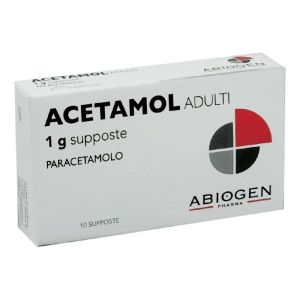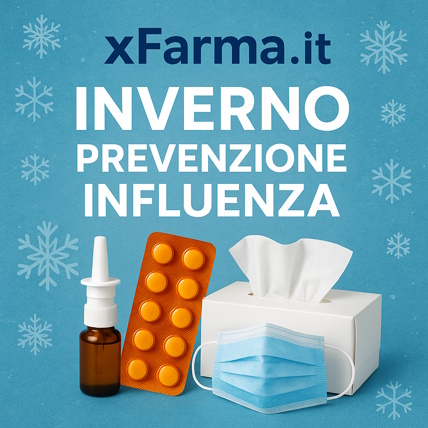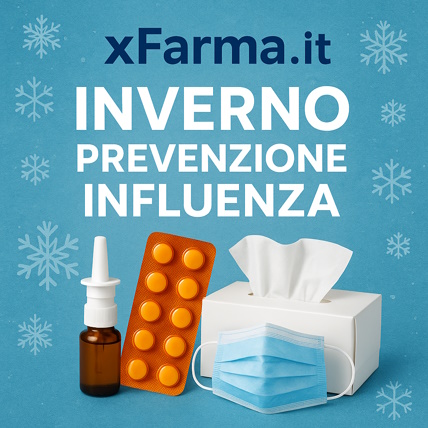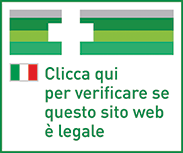Ship in Europe, Find out rates!
Language
Acetamol Adults 1g Paracetamol 10 Suppositories

Regular Price
€5.50
Special Price
€3.08
-44%
Save: €2.42
In stock
Recent lowest price:
€3.01
- box Delivery in Italy in 24/48 and free returns
- star3.000+ positive reviews
- dropboxOver 60,000 products in the catalog
Manufacturer
ABIOGEN PHARMA
SKU
023475066
Active principle
PARACETAMOLO
NAME
ACETAMOL
PHARMACOTHERAPEUTIC CATEGORY
Analgesics and antipyretics.
ACTIVE PRINCIPLES
Effervescent granules: paracetamol 300 mg. Adult tablets: paracetamol 500 mg. Early childhood syrup: paracetamol 25 mg / ml. Early childhood oral drops: paracetamol 3 g / 30 ml. Adult suppositories: paracetamol 1 g. Suppositories: paracetamol 500 mg. Supooste children: paracetamol 250 mg. Early childhood suppositories: paracetamol 125 mg.
EXCIPIENTS
Effervescent granules: citric acid, sodium bicarbonate, compressible sugar. Adult tablets: potato starch, polyvinylpyrrolidone, magnesium stearate. Early childhood syrup: macrogol 6000, glycerol, methyl parahydroxybenzoate, propyl parahydroxybenzoate, sucrose, disodium phosphate dihydrate, monobasic sodium phosphate dihydrate, cream strawberry flavor, purified water. Early childhood oral drops: macrogol 300, glycerol, diethylene glycol monoethyl ether, sorbitol, sodium saccharin, propyl gallate, orange flavor, lemon flavor, purified water. Suppositories: semi-synthetic glycerides, soy lecithin.
INDICATIONS
Symptomatic treatment of fever and mild to moderate pain.
CONTRAINDICATIONS / SECONDARY EFFECT
Hypersensitivity to the active ingredient, to any of the excipients or other closely related substances from a chemical point of view; in particular to other analgesics and antipyretics.
DOSAGE
Below three months, in case of jaundice, it is advisable to reduce the single dose by mouth. For children it is essential to respect the dosage defined according to their body weight and therefore to choose the suitable formulation. In children, use the drug respecting its prescriptions regarding the doses and duration of treatment. In adults the maximum oral dosage is 3000 mg and rectally 4000 mg of paracetamol per day. >> Effervescent granules 300 mg. Children from 8 to 12 years and weighing more than 25 kg: one sachet of 300 mg every 4-6 hours (never less than 4 hours between one and the other); do not exceed 6 sachets in 24 hours. Adolescents from 12 to 18 years and weighing more than 40 kg: one sachet of 300 mg every 4-6 hours (never less than 4 hours between one and the other); if necessary, the dose can be increased up to 600 mg by taking two sachets together. Do not exceed 3 g (10 sachets) in 24 hours. Adults: a dose of 600-900 mg of paracetamol (corresponding to 2-3 sachets) repeatable, if necessary, every 4-6 hours; do not exceed 3 g (10 sachets) in 24 hours. Duration of treatment: Common causes of fever or pain usually resolve quickly. >> Adult tablets 500 mg. Adolescents from 12 to 18 years and weighing more than 40 kg: one 500 mg tablet every 4-6 hours (never less than 4 hours between one and the other); do not exceed 3 g (6 tablets) in 24 hours. Adults: a dose of 500-1000 mg of paracetamol (1-2 tablets) every 4-6 hours (never less than 4 hours between one and the other); do not exceed 3 g (6 tablets) in 24 hours. Duration of treatment: Common causes of fever or pain usually resolve quickly. >> Early childhood syrup 25 mg / ml: the package contains a 5 mL dosing syringe for oral administration, graduated with 0.5 mL markings; one notch corresponds to 12.5 mg of paracetamol. Children up to 18 months and weighing more than 3 kg: normally a dose of 25 mg for every 2 kg of weight can be administered, corresponding to 1 milliliter (mL) of syrup every 6 hours (never less than 4 hours between doses and the other). Children over 18 months and weighing more than 11 kg: normally a dose of 25 mg can be administered for every 2 kg of weight corresponding to 1 milliliter (mL) of syrup every 4 hours (never less than 4 hours between a dose and the other one). The syrup can be taken by children of any age by calculating the correct dose based on weight. However, the drug is identified as Early Childhood because, being packaged in 100 ml bottles, it may be insufficient for children weighing more than 15 kg, failing to cover an adequate number of days of treatment. >> Early childhood oral drops 100 mg / ml Children up to 18 months and weighing more than 3 kg: one drop contains 2.8 mg of paracetamol. Normally the dosage of 4 drops per kg of weight can be administered every 6 hours (never less than 4 hours between one dose and another). Children over 18 months and weighing more than 11 kg: one drop contains 2.8 mg of paracetamol. Normally the dose of 4 drops per kg of weight can be administered every 4 hours (never less than 4 hours between one dose and the other). The product can be taken by children of any age by calculating the correct dose based on weight. However, the drug is identified as Early Childhood because, being packaged in 30 mL bottles, it may be insufficient for children weighing more than 15 kg, failing to cover an adequate number of days of treatment. >> Adult suppositories 1 g. Adolescents from 12 to 18 years and weighing more than 40 kg: one suppository of 1 g every 4-6 hours (never less than 4 hours between one and the other). Do not exceed 3 suppositories in 24 hours. Adults: one suppository of 1 g every 4-6 hours (never less than 4 hours between one and the other). Do not exceed 4 suppositories in 24 hours. Duration of treatment: Common causes of fever or pain usually resolve quickly. >> Suppositories 500 mg. Children from 8 to 12 years and weighing more than 25 kg: one suppository of 500 mg every 4-6 hours (never less than 4 hours between one and the other); do not exceed 4 suppositories in 24 hours. Adolescents from 12 to 18 years and weighing more than 40 kg: a suppository of 500 mg every 4-6 hours (never less than 4 hours between one and the other); do not exceed 6 suppositories in 24 hours. Adults: a 500 mg suppository every 4-6 hours (never less than 4 hours between one and the other); do not exceed 8 suppositories in 24 hours. Duration of treatment: the common causes of fever or pain usually resolve quickly. >> Children suppositories 250 mg. Children from 2 to 8 years and weighing more than 12 kg: a 250mg suppository every 4-6 hours (never less than 4 hours between one and the other); do not exceed 4 suppositories in 24 hours. >> Early childhood suppositories 125 mg. Babies from 3 to 24 months and weighing more than 6 kg: one suppository of 125 mg every 4-6 hours (never less than 4 hours between one and the other). The maximum number of suppositories in 24 hours is 4 for 6-7 kg children, 5 for 7-10 kg children, 6 suppositories cannot be exceeded in heavier children.
STORAGE
This medicine does not require any special storage conditions.
WARNINGS
To avoid toxicity even at therapeutic doses of paracetamol, the proposed dosages must be reduced in case of excessive consumption of alcohol, fasting or poor nutritional status. High or prolonged doses of the product can cause a high-risk liver disease and alterations to the kidney and blood, even serious. Paracetamol should be administered with caution to patients with renal insufficiency, mild to moderate hepatocellular insufficiency (including Gilbert's syndrome), severe hepatic insufficiency, acute hepatitis, concomitant treatment with drugs that impair liver function, glucose-6 deficiency -phosphate dehydrogenase, haemolytic anemia. During treatment with paracetamol, before taking any other drug, check that it does not contain the same active ingredient, since if paracetamol is taken in high doses, serious adverse reactions may occur. During therapy with oral anticoagulants it is recommended to reduce the doses. Do not take this medicine together with other analgesics, antipyretics or non-steroidal anti-inflammatory drugs. In rare cases of allergic reactions, administration should be discontinued and appropriate treatment instituted. Do not administer for more than 3 consecutive days. >> Excipients. Oral drops: Patients with rare hereditary problems of fructose intolerance should not take this medicine. Any browning of the solution does not affect in any way the efficacy and tolerability of the product. Effervescent granules, syrup: Patients with rare hereditary problems of fructose intolerance, glucose-galactose malabsorption, or sucrase isomaltase insufficiency, should not take this medicine. The product contains sugar: this should be taken into account in the case of administration to diabetic subjects or in the course of low-calorie diets. Syrup: contains para-hydroxybenzoates which can cause allergic reactions (even delayed).
INTERACTIONS
Oral absorption of paracetamol depends on the rate of gastric emptying. Therefore, concomitant administration of drugs that slow down (e.g. anticholinergics, opioids) or increase (e.g. prokinetics) the rate of gastric emptying may result in a decrease or an increase in the bioavailability of the product, respectively. Concomitant administration of cholestyramine reduces the absorption of paracetamol. The simultaneous intake of paracetamol and chloramphenicol can 'induce an increase in the half-life of chloramphenicol, with the risk of elevating its toxicity'. The concomitant use of paracetamol (4 g per day for at least 4 days) with oral anticoagulants may induce slight variations in INR values. In these cases, more frequent monitoring of INR values should be performed during concomitant use and after its discontinuation.The drug should be used with caution in patients receiving tranquilizers, antidepressants. Use with extreme caution and under strict control during chronic treatment with drugs that can determine the induction of hepatic monooxygenases or in case of exposure to substances that can have this effect (for example rifampicin, cimetidine, antiepileptics such as glutethimide, phenobarbital, carbamazepine) . The same is true in cases of alcoholism and in patients treated with zidovudine. The administration of paracetamol can interfere with the determination of uricaemia (by the phospho-tungstic acid method) and with that of blood glucose (by the glucose-oxidase-peroxidase method).
SIDE EFFECTS
Skin reactions of various types and severity have been reported with the use of paracetamol, including cases of erythema multiforme, Stevens Johnson syndrome and epidermal necrolysis. Hypersensitivity reactions have been reported, such as angioedema, larynx edema, anaphylactic shock. In addition, the following undesirable effects have been reported: thrombocytopenia, leukopenia, anemia, agranulocytosis, liver function abnormalities and hepatitis, kidney disorders (acute renal failure, interstitial nephritis, haematuria, anuria), gastrointestinal reactions and dizziness.
PREGNANCY AND BREASTFEEDING
Although clinical studies in pregnant or lactating patients have not revealed particular contraindications to the use of paracetamol, nor caused unwanted effects affecting the mother or child, it is recommended to administer the product only in cases of real need.
ACETAMOL
PHARMACOTHERAPEUTIC CATEGORY
Analgesics and antipyretics.
ACTIVE PRINCIPLES
Effervescent granules: paracetamol 300 mg. Adult tablets: paracetamol 500 mg. Early childhood syrup: paracetamol 25 mg / ml. Early childhood oral drops: paracetamol 3 g / 30 ml. Adult suppositories: paracetamol 1 g. Suppositories: paracetamol 500 mg. Supooste children: paracetamol 250 mg. Early childhood suppositories: paracetamol 125 mg.
EXCIPIENTS
Effervescent granules: citric acid, sodium bicarbonate, compressible sugar. Adult tablets: potato starch, polyvinylpyrrolidone, magnesium stearate. Early childhood syrup: macrogol 6000, glycerol, methyl parahydroxybenzoate, propyl parahydroxybenzoate, sucrose, disodium phosphate dihydrate, monobasic sodium phosphate dihydrate, cream strawberry flavor, purified water. Early childhood oral drops: macrogol 300, glycerol, diethylene glycol monoethyl ether, sorbitol, sodium saccharin, propyl gallate, orange flavor, lemon flavor, purified water. Suppositories: semi-synthetic glycerides, soy lecithin.
INDICATIONS
Symptomatic treatment of fever and mild to moderate pain.
CONTRAINDICATIONS / SECONDARY EFFECT
Hypersensitivity to the active ingredient, to any of the excipients or other closely related substances from a chemical point of view; in particular to other analgesics and antipyretics.
DOSAGE
Below three months, in case of jaundice, it is advisable to reduce the single dose by mouth. For children it is essential to respect the dosage defined according to their body weight and therefore to choose the suitable formulation. In children, use the drug respecting its prescriptions regarding the doses and duration of treatment. In adults the maximum oral dosage is 3000 mg and rectally 4000 mg of paracetamol per day. >> Effervescent granules 300 mg. Children from 8 to 12 years and weighing more than 25 kg: one sachet of 300 mg every 4-6 hours (never less than 4 hours between one and the other); do not exceed 6 sachets in 24 hours. Adolescents from 12 to 18 years and weighing more than 40 kg: one sachet of 300 mg every 4-6 hours (never less than 4 hours between one and the other); if necessary, the dose can be increased up to 600 mg by taking two sachets together. Do not exceed 3 g (10 sachets) in 24 hours. Adults: a dose of 600-900 mg of paracetamol (corresponding to 2-3 sachets) repeatable, if necessary, every 4-6 hours; do not exceed 3 g (10 sachets) in 24 hours. Duration of treatment: Common causes of fever or pain usually resolve quickly. >> Adult tablets 500 mg. Adolescents from 12 to 18 years and weighing more than 40 kg: one 500 mg tablet every 4-6 hours (never less than 4 hours between one and the other); do not exceed 3 g (6 tablets) in 24 hours. Adults: a dose of 500-1000 mg of paracetamol (1-2 tablets) every 4-6 hours (never less than 4 hours between one and the other); do not exceed 3 g (6 tablets) in 24 hours. Duration of treatment: Common causes of fever or pain usually resolve quickly. >> Early childhood syrup 25 mg / ml: the package contains a 5 mL dosing syringe for oral administration, graduated with 0.5 mL markings; one notch corresponds to 12.5 mg of paracetamol. Children up to 18 months and weighing more than 3 kg: normally a dose of 25 mg for every 2 kg of weight can be administered, corresponding to 1 milliliter (mL) of syrup every 6 hours (never less than 4 hours between doses and the other). Children over 18 months and weighing more than 11 kg: normally a dose of 25 mg can be administered for every 2 kg of weight corresponding to 1 milliliter (mL) of syrup every 4 hours (never less than 4 hours between a dose and the other one). The syrup can be taken by children of any age by calculating the correct dose based on weight. However, the drug is identified as Early Childhood because, being packaged in 100 ml bottles, it may be insufficient for children weighing more than 15 kg, failing to cover an adequate number of days of treatment. >> Early childhood oral drops 100 mg / ml Children up to 18 months and weighing more than 3 kg: one drop contains 2.8 mg of paracetamol. Normally the dosage of 4 drops per kg of weight can be administered every 6 hours (never less than 4 hours between one dose and another). Children over 18 months and weighing more than 11 kg: one drop contains 2.8 mg of paracetamol. Normally the dose of 4 drops per kg of weight can be administered every 4 hours (never less than 4 hours between one dose and the other). The product can be taken by children of any age by calculating the correct dose based on weight. However, the drug is identified as Early Childhood because, being packaged in 30 mL bottles, it may be insufficient for children weighing more than 15 kg, failing to cover an adequate number of days of treatment. >> Adult suppositories 1 g. Adolescents from 12 to 18 years and weighing more than 40 kg: one suppository of 1 g every 4-6 hours (never less than 4 hours between one and the other). Do not exceed 3 suppositories in 24 hours. Adults: one suppository of 1 g every 4-6 hours (never less than 4 hours between one and the other). Do not exceed 4 suppositories in 24 hours. Duration of treatment: Common causes of fever or pain usually resolve quickly. >> Suppositories 500 mg. Children from 8 to 12 years and weighing more than 25 kg: one suppository of 500 mg every 4-6 hours (never less than 4 hours between one and the other); do not exceed 4 suppositories in 24 hours. Adolescents from 12 to 18 years and weighing more than 40 kg: a suppository of 500 mg every 4-6 hours (never less than 4 hours between one and the other); do not exceed 6 suppositories in 24 hours. Adults: a 500 mg suppository every 4-6 hours (never less than 4 hours between one and the other); do not exceed 8 suppositories in 24 hours. Duration of treatment: the common causes of fever or pain usually resolve quickly. >> Children suppositories 250 mg. Children from 2 to 8 years and weighing more than 12 kg: a 250mg suppository every 4-6 hours (never less than 4 hours between one and the other); do not exceed 4 suppositories in 24 hours. >> Early childhood suppositories 125 mg. Babies from 3 to 24 months and weighing more than 6 kg: one suppository of 125 mg every 4-6 hours (never less than 4 hours between one and the other). The maximum number of suppositories in 24 hours is 4 for 6-7 kg children, 5 for 7-10 kg children, 6 suppositories cannot be exceeded in heavier children.
STORAGE
This medicine does not require any special storage conditions.
WARNINGS
To avoid toxicity even at therapeutic doses of paracetamol, the proposed dosages must be reduced in case of excessive consumption of alcohol, fasting or poor nutritional status. High or prolonged doses of the product can cause a high-risk liver disease and alterations to the kidney and blood, even serious. Paracetamol should be administered with caution to patients with renal insufficiency, mild to moderate hepatocellular insufficiency (including Gilbert's syndrome), severe hepatic insufficiency, acute hepatitis, concomitant treatment with drugs that impair liver function, glucose-6 deficiency -phosphate dehydrogenase, haemolytic anemia. During treatment with paracetamol, before taking any other drug, check that it does not contain the same active ingredient, since if paracetamol is taken in high doses, serious adverse reactions may occur. During therapy with oral anticoagulants it is recommended to reduce the doses. Do not take this medicine together with other analgesics, antipyretics or non-steroidal anti-inflammatory drugs. In rare cases of allergic reactions, administration should be discontinued and appropriate treatment instituted. Do not administer for more than 3 consecutive days. >> Excipients. Oral drops: Patients with rare hereditary problems of fructose intolerance should not take this medicine. Any browning of the solution does not affect in any way the efficacy and tolerability of the product. Effervescent granules, syrup: Patients with rare hereditary problems of fructose intolerance, glucose-galactose malabsorption, or sucrase isomaltase insufficiency, should not take this medicine. The product contains sugar: this should be taken into account in the case of administration to diabetic subjects or in the course of low-calorie diets. Syrup: contains para-hydroxybenzoates which can cause allergic reactions (even delayed).
INTERACTIONS
Oral absorption of paracetamol depends on the rate of gastric emptying. Therefore, concomitant administration of drugs that slow down (e.g. anticholinergics, opioids) or increase (e.g. prokinetics) the rate of gastric emptying may result in a decrease or an increase in the bioavailability of the product, respectively. Concomitant administration of cholestyramine reduces the absorption of paracetamol. The simultaneous intake of paracetamol and chloramphenicol can 'induce an increase in the half-life of chloramphenicol, with the risk of elevating its toxicity'. The concomitant use of paracetamol (4 g per day for at least 4 days) with oral anticoagulants may induce slight variations in INR values. In these cases, more frequent monitoring of INR values should be performed during concomitant use and after its discontinuation.The drug should be used with caution in patients receiving tranquilizers, antidepressants. Use with extreme caution and under strict control during chronic treatment with drugs that can determine the induction of hepatic monooxygenases or in case of exposure to substances that can have this effect (for example rifampicin, cimetidine, antiepileptics such as glutethimide, phenobarbital, carbamazepine) . The same is true in cases of alcoholism and in patients treated with zidovudine. The administration of paracetamol can interfere with the determination of uricaemia (by the phospho-tungstic acid method) and with that of blood glucose (by the glucose-oxidase-peroxidase method).
SIDE EFFECTS
Skin reactions of various types and severity have been reported with the use of paracetamol, including cases of erythema multiforme, Stevens Johnson syndrome and epidermal necrolysis. Hypersensitivity reactions have been reported, such as angioedema, larynx edema, anaphylactic shock. In addition, the following undesirable effects have been reported: thrombocytopenia, leukopenia, anemia, agranulocytosis, liver function abnormalities and hepatitis, kidney disorders (acute renal failure, interstitial nephritis, haematuria, anuria), gastrointestinal reactions and dizziness.
PREGNANCY AND BREASTFEEDING
Although clinical studies in pregnant or lactating patients have not revealed particular contraindications to the use of paracetamol, nor caused unwanted effects affecting the mother or child, it is recommended to administer the product only in cases of real need.
| Destination | Cost | Detail |
|---|---|---|
| Italy | €5,90* | 24/72H |
| Austria, France, Germany, Slovenia | € 13* | 3 days |
| Belgium, Luxembourg, Portugal, Netherlands, Spain | € 14* | 4 days |
| Bulgary, Cechia, Hungary, Poland, Romania, Slovakia | € 19* | 5 days |
| Denmark, Estonia, Finland, Ireland, Lithuania, Latvia ,Sweden | € 22* | 5 days |
| United Kingdom, Switzerland, Greece, Malta/td> | € 30* | 7 days |
| Canada | € 40 | 7 Days |
European shipments with express courier: FedEx, MBE, DHL
*For the shipment outside band B ther's an extra cost of 22€ *For the shipment outside band C ther's an extra cost of 30€ Delivery Times exclude Saturday and Holidays
For Islands and Areas of difficult Accessibility the shipments are made in 72 hours and the cost will be increased by 15€
The images of the products shown on our site are purely indicative and may differ in shape, color, text and packaging shown on them. Given the difficulty of updating all the products on our site in real time or any errors, XFarma.it, all products will be identified through SKU MINSAN (code of the Ministry of Health).


